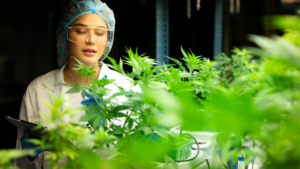
The UK medical cannabis industry faces several challenges. One such example is the many barriers that many new businesses face when trying to secure a license to manufacture and distribute medical cannabis.
In our Comprehensive Guide to Good Manufacturing Practice, we highlighted some of the issues that companies which have no existing authorisations in the UK face when applying for an MHRA license.
What is an MHRA license?
An MHRA license is required to manufacture Cannabis-based products for medicinal use (CBPMs) and active pharmaceutical ingredients (API). This license requires an inspection of the site to confirm it has an appropriate facility, staff and Pharmaceutical Quality Management System and has carried out the required activities (including process and analytical validation).
Completing all of the necessary processes required for the MHRA is not possible without permission to handle controlled substances, which in turn is not possible until a company holds a Home Office license. There currently isn’t a way to operate both authorisation processes independently because each regulatory authorisation process requires some aspects of the other. Only when both MHRA and the Home Office have granted appropriate authorisations can medicines be supplied. Thus we face a chicken-and-egg-like scenario.

These barriers unfortunately prevent new companies from easily entering the market, which is already fragmented and is significantly hindering both patient volume growth and the number of new medical cannabis companies entering the market, who are all essentially fighting for the same slice of the pie.
While discussions are in place to create a more efficient and fair process, the UK Government has outlined an intermediary approach for companies that do not already hold the necessary authorisations from either the Home Office or the MHRA. The following summarises the latest guidance, last updated here in March 2023.
The MHRA Application Process Explained
1.
The Site Applies to the MHRA for the Appropriate License or Registration
• The site must be inspection-ready prior to applying
• An operational Pharmaceutical Quality Management System (QMS) must be in place
• A suitable and qualified facility with all equipment installed and qualified up to at least OQ.
• All relevant personnel must meet EU GMP requirements
2.
MHRA to Carry Out a Remote Inspection
• The QMS is assessed to enquire that it will support the manufacture of medicinal products
• The Standard Operating Procedures put in place to support activity will be reviewed
• Facility design & all equipment to be assessed for the suitability of intended use
• If the inspection is successful, this will then be communicated to the Home Office
• It is worth noting that at this stage, no GMP or GDP certificate is issued
3.
Application to Home Office for Controlled Drug License
• If the site has received a successful remote inspection, the site may then submit an application to the Home Office
• The Home Office will carry out an on-site inspection to assess the suitability of facilities and procedures for the handling of all cannabis-based materials
• If suitability is confirmed and the assessment is passed, the Home Office will then issue a Controlled Drugs License
4.
Site Completes Outstanding Validation Activities
• With the Home Office License now issued, the site is now approved to handle cannabis materials and complete the required validation activities (process & analytical)
• When these activities are completed and fully reported, the site confirms to the MHRA that all activities have been completed and that they are inspection ready
5.
MHRA Carries Out On-Site Inspection
• Validation and other aspects that have not already been covered in the Remote Inspection are reviewed
• Appropriate authorisation and GMP/GDP certificates are issued upon successful completion of on-site inspection
• If the inspection proves to be unsuccessful, the Home Office will then be notified
At the point of application, you should have all necessary systems, equipment, and procedures in place. All qualification and validation of the facility and equipment should be completed up to the point of at least operational qualification (OQ). As stated above it is accepted that no process validation runs can be completed at the point of application as you will be unable to handle the controlled materials at that time and that some PQ activities may also be incomplete.
If a company applies for a licence/registration before they are ready for inspection (e.g. the equipment is not in place or appropriately qualified) and this is identified during an assessment of the application, it will be rejected before commencing the initial remote inspection. If this is determined during the remote inspection, then the inspection will be ceased, the application will not be supported, and the company will be liable for the fees incurred up to that point. A further application will then need to be submitted.
We hope that this summary has provided some guidance for new companies entering the market. We are strong advocates of industry reform and understand that much more needs to be done to improve the fragmented market and facilitate a wider choice for medical cannabis consumers.
To keep updated with more insights like this, make sure you’re following our social media channels or click here to learn more about our project.
We think you might also like this posts:

The Future of European Cannabis in 2024
Organic medicines, like cannabis, are making a comeback after years of prohibition, but the truth is cannabis has been utilised as a healing plant for millennia.
… Read More

The Long History of Cannabis as Medicine: A Global Perspective
Organic medicines, like cannabis, are making a comeback after years of prohibition, but the truth is cannabis has been utilised as a healing plant for millennia.
… Read More

Crypto Adoption: Is It Steadily Moving Towards the Mainstream?
The world of cryptocurrency is still in its early days, and there is ample opportunity for wider adoption and growth. While Bitcoin has been around for over a decade now, estimates show crypto adoption rates are still in the single
